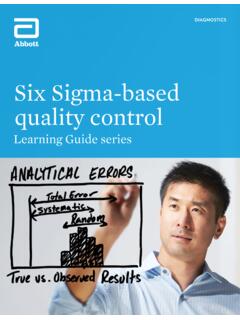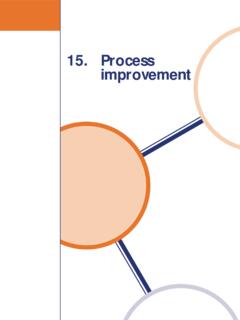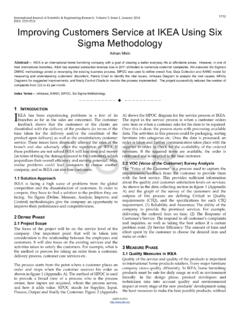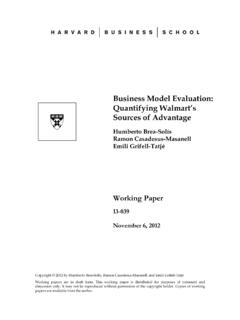Transcription of Lean Six Sigma Green Belt Study Guide - AALSSC
1 1 Lean Six Sigma Green Belt Study Guide Name: _____ Video lessons aligned to this Study Guide can be found at: Print this Guide double sided and bind it for a booklet feel. ---------------------------------------- ---------------------------------------- ---------------------------------------- ------------------------ 2 Letter from the Director First, let me congratulate you for pursing your Lean Six Sigma Green Belt certification and welcome to the American Association for Lean Six Sigma Certification ( AALSSC ). Obtaining a Lean Six Sigma certification is one of the most rewarding and valuable professional accomplishments you can achieve. The professional opportunities for a Lean Six Sigma Green Belt are vast and apply all industries.
2 This is an exciting time for Lean Six Sigma professionals and let me be the first to welcome you to the community. The amount of knowledge required for an AALSSC certification is extensive, but not overwhelming. You can do it! The core tenants of AALSSC certifications is they must be relevant and attainable. By only testing the most relevant tools and methods within Lean Six Sigma we have removed some of the knowledge areas deemed not relevant enough thus making the exam more attainable. As a certified Lean Six Sigma Green Belt you will be expected to effectively facilitate teams, be a process improvement specialist, and a problem solving expert. The exam tests your knowledge, skills and abilities across these focus areas. This is your Study Guide , treat it as such.
3 Write your name on it, complete it using your words and follow the concepts outlined. By writing you will retain the information and make this Study Guide a useful part of your reference library. Plus, this Study Guide can be used when taking an AALSSC Green Belt certification exam. Good luck and welcome to AALSSC your road to success. Mr. Erik Christensen Director of Certification, AALSSC Erik Christensen 3 Table of Contents Section #1 - Introduction Background The Green Belt s impact Section #2 Lean Six Sigma overview and process mapping Six Sigma overview Lean overview TIM WOOD (U) Principles of Lean Seeing the process Timing the value stream and action planning Section #3 - Facilitation Team facilitation Facilitation facilitator tools Team facilitation - stages of team development Facilitation - decision making Facilitation - team members and events Section #4 - Problem solving Problem solving Change management and stakeholders Problem solving SWOT and SMART Root Cause Analysis tools Section #5 Lean Six Sigma countermeasures 5S, standard work and visual management Poka-Yoke, quick changeover, leveling and cell design Sustainment actions 4 Section #1 - Introduction Background Lean Six Sigma : Lean Six Sigma is the combining of two methodologies Lean and Six Sigma .
4 Lean Six Sigma takes advantage of the "value--added" focus of Lean while maintaining statistical tools of Six Sigma . Toyota is the company credited with pioneering Lean? Motorola is credited with pioneering Six Sigma ? Q: What is the primary focus of Lean? Six Sigma ? Green Belt skill set (expectations): Problem solving Process improvement Team facilitation Quality and Value: Value: What customers are willing to pay for. Quality: Meeting or exceeding customer expectations. Q: How are quality and customer satisfaction related? Who defines quality? Notes: 5 The Green Belt s impact Green belts impact is felt the strongest across four main areas of the organization. 1) Cost of Poor Quality (COPQ) Costs that would disappear if systems, processes and products were perfect.
5 Obvious costs: Overtime wages, scraped products, energy, warranty claims, raw materials, etc. Hidden costs: Reputation, word of mouth, brand value, loss of repeat customer, employee morale, etc. Notes: 2) Opportunity losses By spending resources to respond to and fix defects the company is not exploring new ways to satisfy the customer. Following the Kano Model seek to find ways to provide customers with wow factors Satisfier: Customer asks for Dis-satisfier: Customer expects to be there without asking Delighter: Customer does not know to ask for it 6 3) Employee Morale - Lean Six Sigma is founded on the core concept of respect for people. A bad process defeats a good employee A process that permits employee success and offers a chance to work with pride increases morale High morale increases productivity, energizes the work force and reduces turn-over Notes: 4) Workplace safety A safe work environment shows respect for employees and what they contribute.
6 Physical work areas and processes are intertwined. Costs of employee injury is high. Notes: 7 Section #2 - Six Sigma overview Six Sigma overview Sigma is a statistical unit of measure which reflects process capability. Sigma is mathematical term: Deviation from the mean 6 deviations from the mean if measuring quality, a six Sigma process would only produce defects per million opportunities (DPMO) Follows DMAIC stage gate cycle for project execution. Define Measure Analyze Improve Control Focus efforts following the transfer function Y=f(x) which means the output (Y) is the function of the inputs(x). Example: The number on the bathroom scale is Y, while exercise and calorie intake are both x. To change Y you must focus on the (x)s.
7 Business measure and quality defects are Y, focus on the (x)s to move the Y. Six Sigma s primary objectives is to reduce variation International standards organization (ISO): Helps organization produce high quality goods (continuous improvement) Companies can get ISO certified Malcom Baldrige national quality award presented by POTUS annually Notes: 8 Lean overview Lean is a systematic approach to identify waste, focus activities on eliminating it, and maximize (or make available) resources to satisfy other requirements. Lean is term used to describe Toyota Production System (TPS) Lean fundaments Go/See: Go to the Gemba and see processes first hand Ask why: Question assumption, find root causes Show respect: Provide employees with a safe, functional work environment Gemba: The place of actual work.
8 Kaizen: Continuous Betterment (Improvement). Q: What actions are managers expected to take based on these concepts? How do these concepts shape organizational culture? Notes: 9 TIM WOOD (U) Understand value adding vs. non-value adding steps in a process. Defined by the customer Identify and eliminate waste (TIM WOOD U) Waste is like a saboteur who is disrupting normal operations Transportation: Movement of material, information, people or equipment that does not add value Inventory: More information, projects, material on hand than is needed right now Motion: Movements of people that does not add value Waiting: Idle time created when material, information, people, or equipment is not ready Over-Production: Generating more than is needed right now Over-Processing: Effort that creates no value from the customer viewpoint Defects: Work that contains errors, re-work, mistakes or lacks something necessary Under-Utilization.
9 Any failure to use the time and talents of people WIP: Work in process (not raw material, not finished goods) form of inventory waste. Notes: 10 Principles of Lean 1. Define value from the standpoint of the end customer. 2. Map the value stream. 3. Create flow by making the steps occur in tight sequence. 4. Let the customers pull value from the process by keeping pace with the rate of customer demand. 5. Continuously improve and strive for the Ideal process. Notes: 11 Seeing the Process Concept: Teams must be able to see and analyze a process before they can improve it. Tool: Process walk see first-hand how processes are being accomplished. Literally walk the process from start to finish, then from finish to start best done in pairs Capture data, take measurements, speak to workers Notes: Tool: Spaghetti diagram visual display of motion or transportation waste.
10 Diagrams the motion or transportation of a product or employee. Shows how the process moves through the physical world basis for layout changes Notes: 12 Tool: Value stream map visual display of all the actions taken to bring a product or service to the customer. Three types: Current state: How we do it today Ideal state: Perfect world process Future state: Target process with less waste Swim lanes: VSM format that shows movement of process between department Value added step: Customer would pay for it, done correctly the first time and changes the form, fit or function Non-Value added step: Does not meet above criteria Business value: Non-value adding steps required for business purposes (Ex. paying taxes, reporting data).



